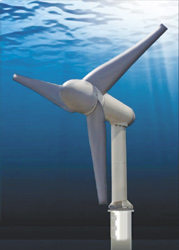Harnessing the Waves
The notion that ocean tides can be harnessed to create pollution-free electricity made a crucial jump from drawing board to reality this fall. After seven years of prototype testing and preliminary studies, state and federal regulators have approved Arlington, Virginia-based Verdant Power’s plan to install six underwater turbines in New York City. This array—which could eventually include as many as 300 turbines—is expected to be the first grid-connected, multi-turbine source of tidal energy in the world.

Resembling underwater windmills, the 15-foot-diameter turbines will tap the tidal flow of the East River when they are completed in 2007. The narrow eastern channel of the river moves up to six miles an hour, making it one of the fastest water bodies on the East Coast. The sleek, three-pronged turbines swivel to face the oncoming tide, generating up to 35 kilowatts of electricity each.
The goal, says Verdant Power President Trey Taylor, is to generate an environmentally sustainable and commercially viable source of electricity near where it’s consumed. During an 18-month trial, the turbines will help power a supermarket and public parking garage a few hundred feet away. If all goes as planned, the array will expand to produce five to 10 megawatts—enough power for 4,000 homes.
The Verdant Power project marks a "very important first step" in the development of ocean energy projects in the U.S., says Carolyn Elefant of the Ocean Renewable Energy Coalition. France has harnessed tidal power since 1966, and there are tidal power plants operating in Russia and Canada. Interest in ocean-energy projects in the U.S. lost momentum under President Reagan and has only rebounded in the past decade, Elefant adds.
There are now several proposals in development from Rhode Island to Hawaii, but getting them launched is no small challenge. Each project must be extensively researched, tested, sited and licensed, requiring time and millions of dollars of start-up capital. State governments have subsidized some projects, and the energy bill President Bush signed in August offered the first federal recognition to renewable ocean energy in two decades, but also bypassed giving it a key tax credit.
Still, the tide appears to have turned in favor of ocean energy, according to Jeff Deyette, an energy analyst at the Union of Concerned Scientists. "There’s a growing awareness," he says, "that our current energy system is unsustainable. There is an interest in finding ways to generate electricity from cleaner, reliable energy sources."

